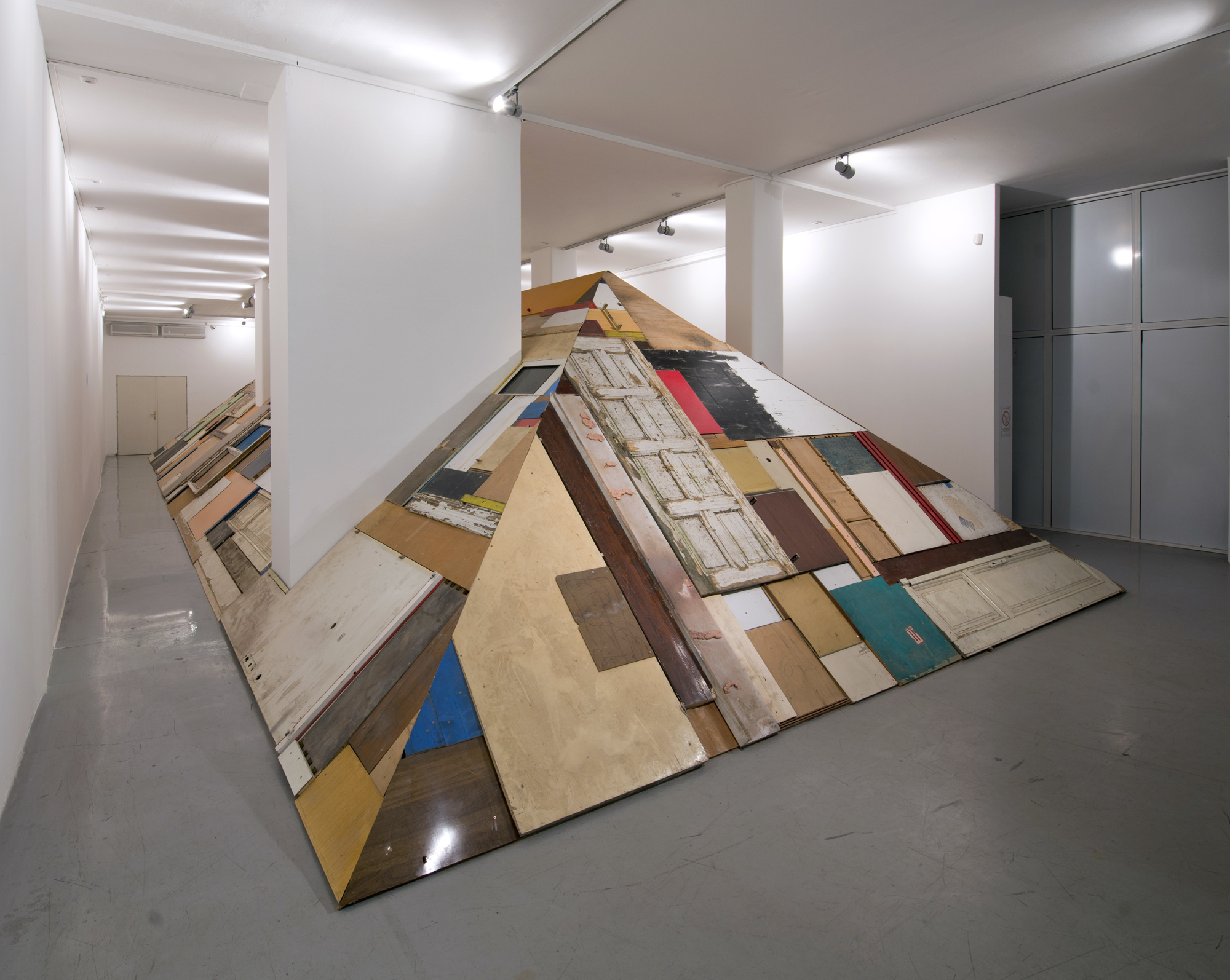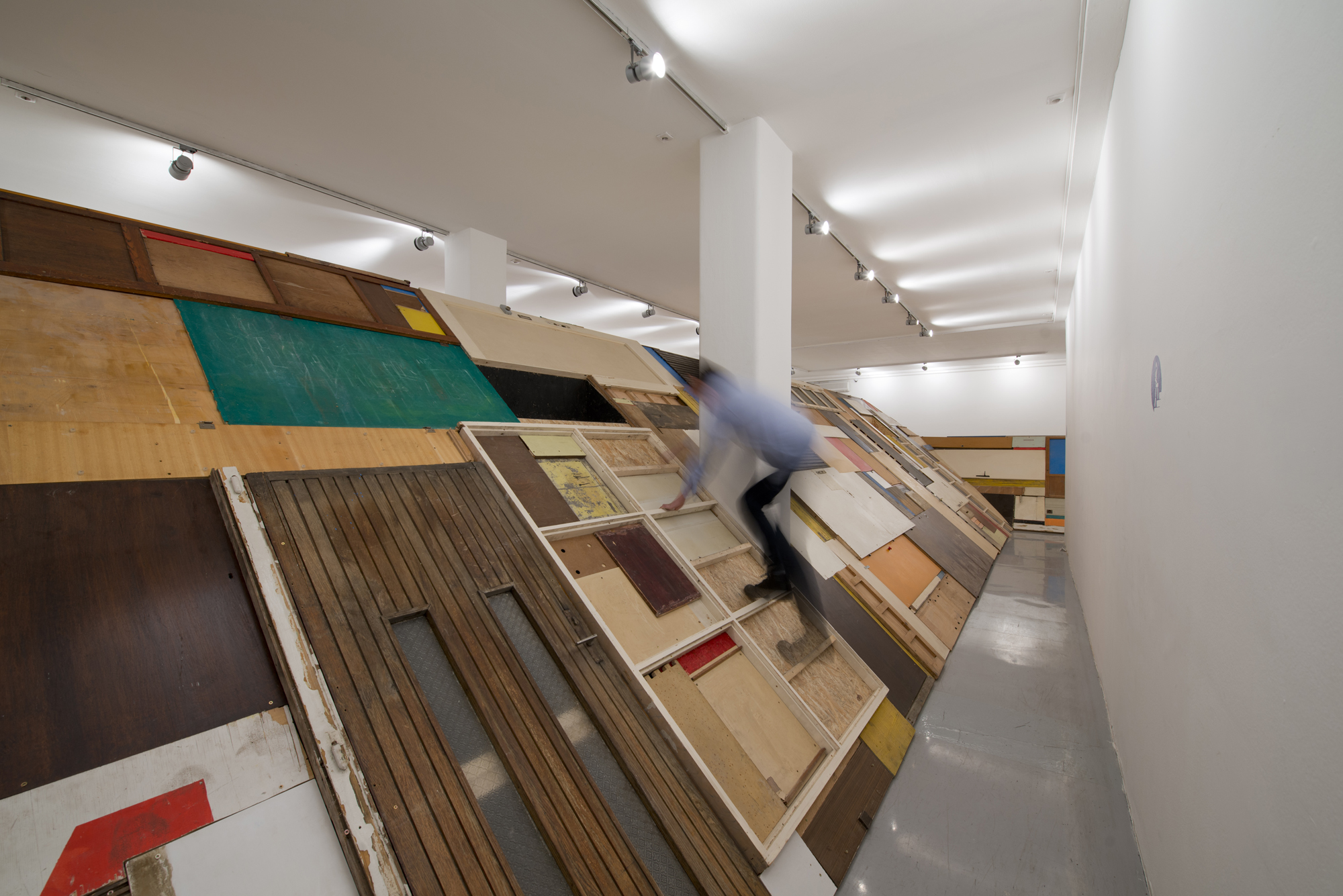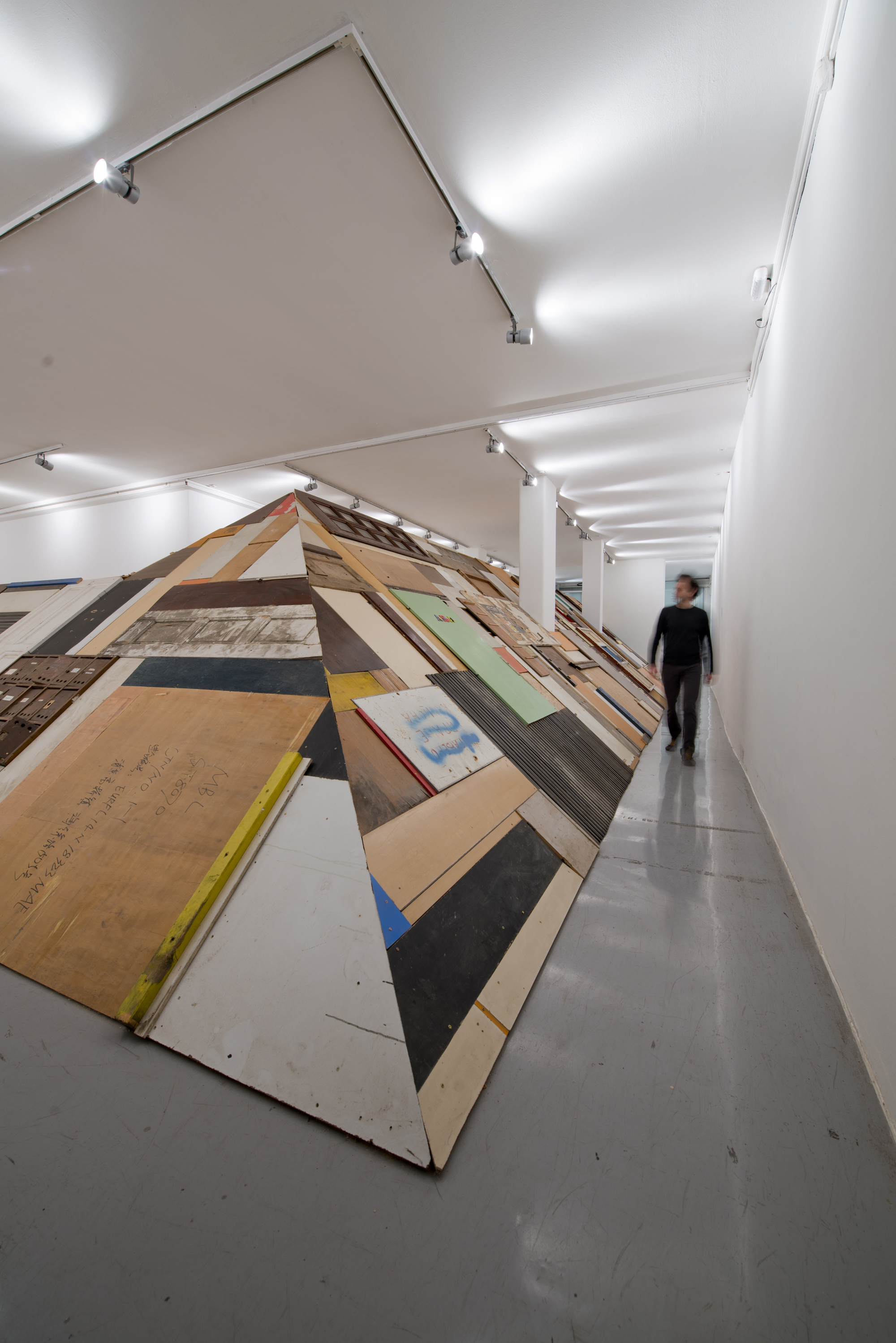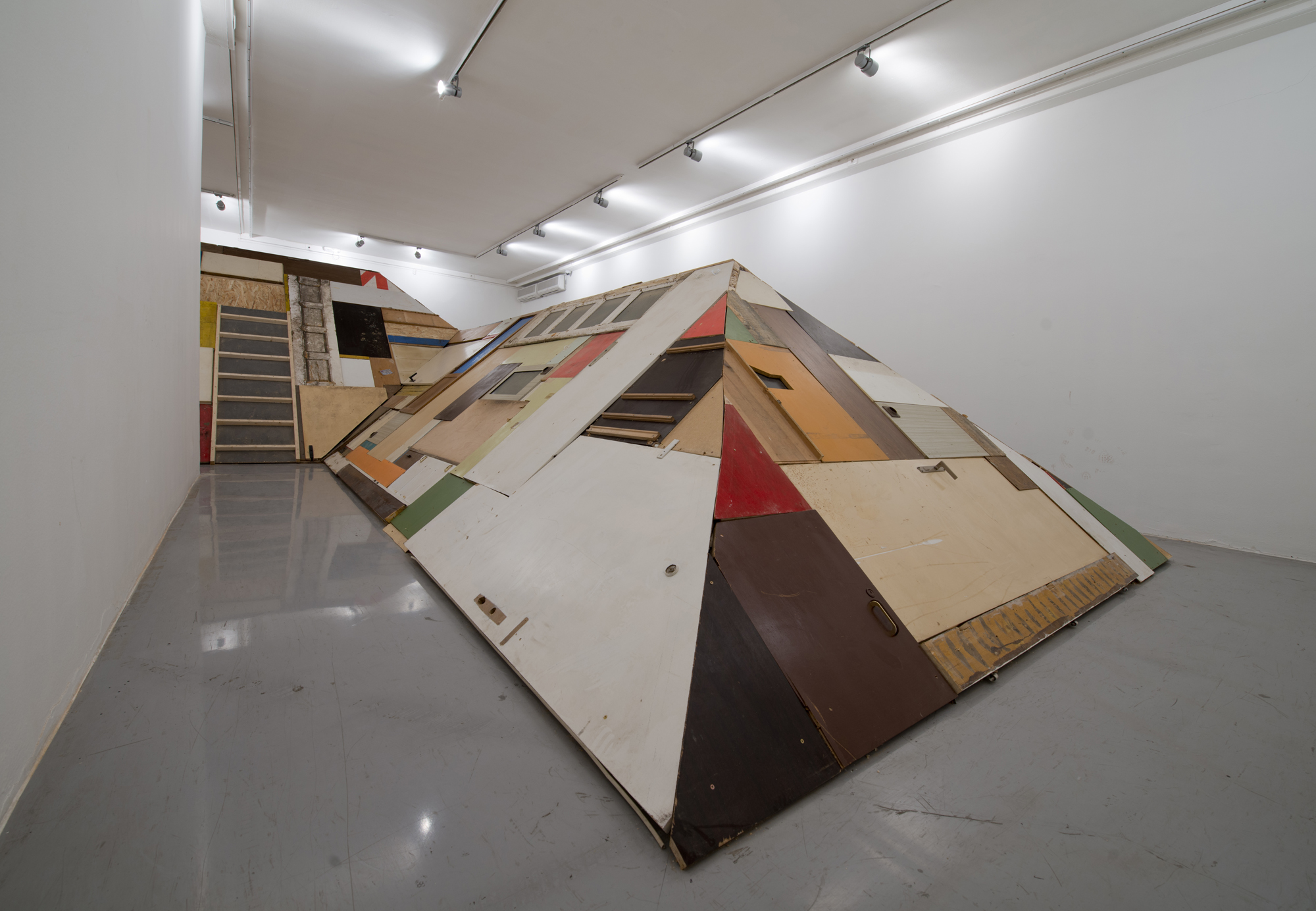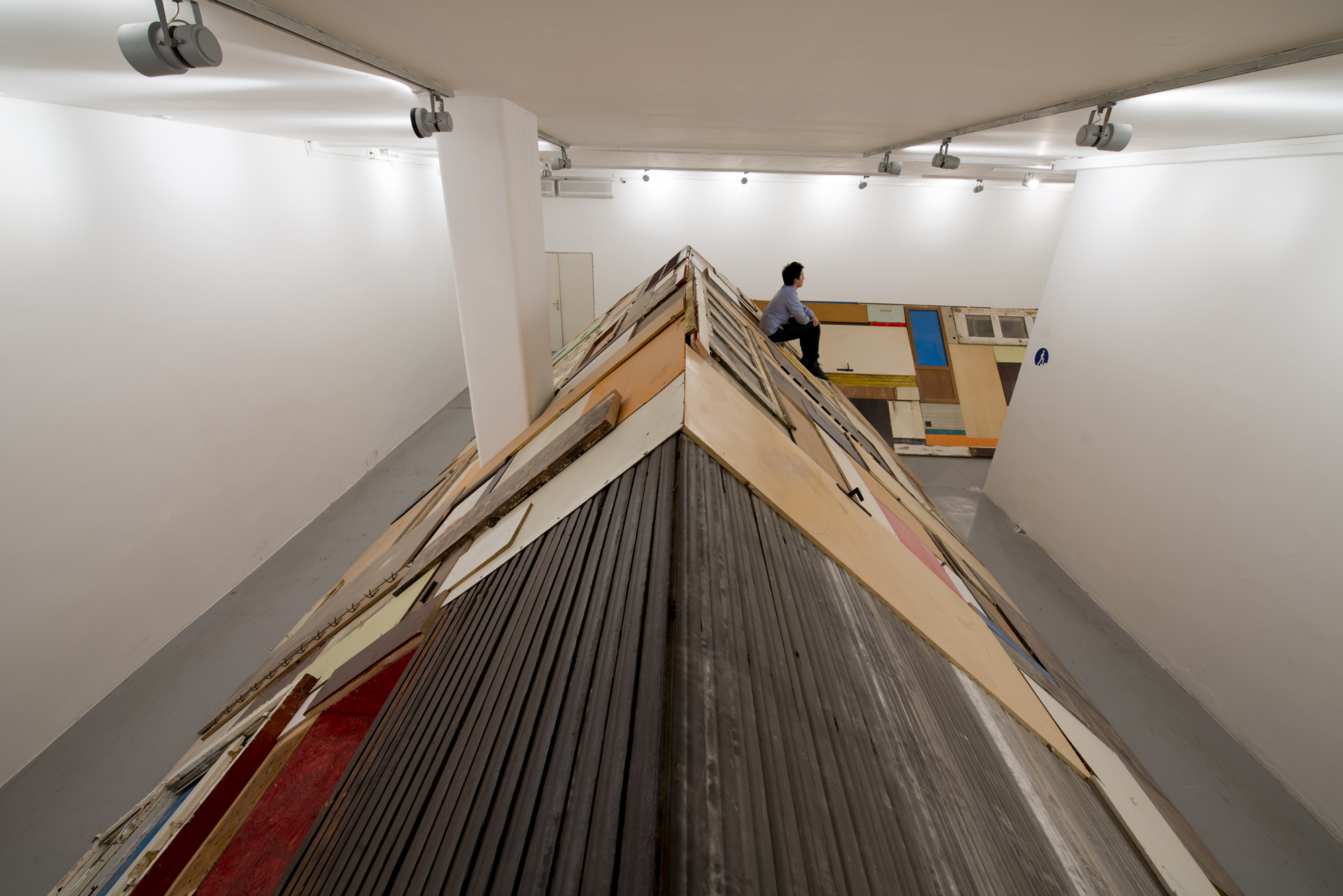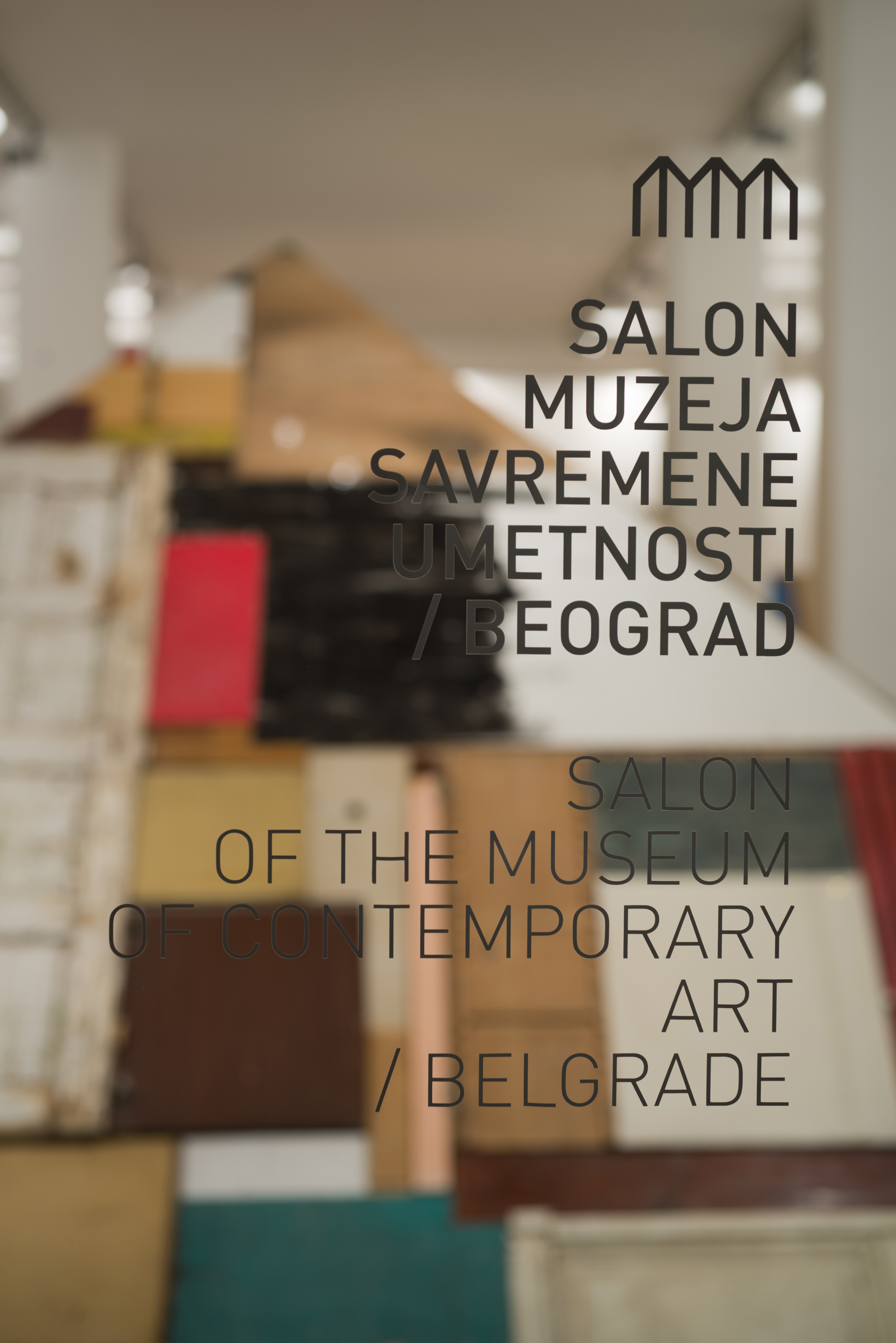Superstructure, 2016
wood, metal, glass, 1760 x 1150 x 240 cm
production: MoCAB, Serbia
curator: Zoran Erić
photos: Nebojša Vasić
On the exhibition title
In the English language, the word superstructure has several meanings all of which derive from different viewpoints and are manifest in the layered artistic references in the work of Branislav Nikolić.1 This word can be primarily interpreted in architectural language as an extension and refers to a part of a building or some structure which is above the foundations. The abstract connotations of the word are a physical or conceptual structure developed from base form. Finally, there are the more discursive meanings of the word which are also relevant to the artistic field of creativity in which Nikolić is active and derive from Marxist theory in which social ideology and institutions are seen as additions or a superstructure to the base which comprises the forces and relations of production and the economy. The methodology behind the work of Branislav Nikolić is enmeshed with all the above mentioned meanings of the word superstructure so that this word imposes itself as an obligatory polysemic starting point for the analysis of the artistic work and the project realised in the Salon of the Museum of Contemporary Art.
On the methodology of the work — secondary architecture
According to statements from the artist, the main impulse for the development of this specific methodology, which is embodied in the gathering of discarded architectural elements, of interior fixtures, furniture and wooden material and in their reuse in the artistic process and as construction materials of artistic works, occurred during his residency on post-graduate studies in the Netherlands.2 Instead of focusing on working in his studio and the medium of painting, Nikolić made up his mind to systematically “feel the pulse of the city” and tracking the processes of urban change in different quarters and the dynamics of urban life, he found a subject, the resources and concrete material which he would translate into his work. Conceived as objects, sculptures or installations, these works in their materialisation include elements of urban life and also contain intimate familial narratives and histories which have been discarded in the public space, in the street, in rubbish bins, and the artist re-inscribes and incorporates these in his work. For Nikolić the next significant step in developing such an artistic choice is to present a project and methodological approach which is characterised under the syntagm “secondary architecture” which refers to the economic activity of collecting and recycling material specific to the construction of “cardboard houses” in Roma settlements. Drawing on a specific approach to building and the craft based skills of Boban Mladenović,3 the collaborator in this project, Nikolić transforms the art of “putting a roof over one’s head”, a basic existential solution for numerous Roma families, into a series of art works whose form is architectural and whose forceful social message is one of “the right to the city”4 and to elementary living conditions for all social groups, particularly the most disenfranchaised.
Spatialising the concept
All of these references are summed up in and by the project conceived for the MoCAB Salon which endows them in the actual architecture of the gallery space with all its features with a new dimension of spatiality and assembly. The work’s dimensions fully “take over” the gallery and transform features such as pillars into chimneys which protrude from the four slate roof structure. On the other hand, the roof structure/extension voided of its inherent utility is transformed into an artistic object, a sculpture of monumental proportions but also of a limited duration since when the exhibition finishes, the exhibit will be fully dissembled and its parts put back into circulation and recycled in the city rubbish dumps and again be used to build “cardboard houses”. Technically, the final outcome of the work is characterised by a combination of a simple craft based approaches for the construction of a temporary dwelling, like those in Roma settlements, and the addition of a painterly and sculptural treatment inscribed in how the work is built, assembled and slotted together like a large collage of variegated and discarded elements. Just as in the collaborations with Boban Mladenović who alone carried out most of the work according to the artist’s concept, and now in the collaboration with the technical team of the Museum, a working dynamic was created in which all the participants take part equally in the process of creating and building the work. A particularly important aspect of this work is the idea of interaction, the public is invited to literally climb onto the roof and to view the work from a position which best reveals the architectural and building steps necessary to its production. The view from the top of the roof emphasises how the totality, the unity and architectural-sculptural monolithism of the work opposes the separateness of all the individual elements and details of which it is made, which in itself is another possible way of perceiving the work.
Collage as a chronicle of urban life
Another aspect whose starting point is not the totality of the work but its details and elements can be read by the how the artist accentuates the collage-like fine art treatment which itself creates a new complicated story out of the numerous surviving and discarded family histories of the home, the experience of growing up in different periods of the recent history of Belgrade. Such a narrative is followed by the special aesthetics of interiors, entrance doors, post boxes and other useful emphemeris and used elements. The artist wishes to reveal and emphasise the vitality of these elements through using them to produce an entirely new work which endows them with a new utilitarian value, this time one from the sphere of art. In this way the work becomes a special type of chronicle of urban life in homes, stripped bare, in the used state it was found in, without any sentimentality for the intimate stories hidden in every found object. That is why the interraction with the public comes down to being able to move about and climb onto the work, the roof, and not being able to enter into its interior via the numerous shut doors behind which all the hidden, residual and impregnated private residential histories are symbolised by their fragmentation on the work’s surface.
Scanning the social processes
As well as this, Nikolić’s work presents a powerful metaphor of the social change in Serbia on which the artist reflects and which he relates to the forms of economic and force migration which came in the aftermath of the wars of the 1990s when the main symptom of this process of change was the spread of unregulated building in urban areas. Even though this type of building is frequently regarded as an “architectural pestilence” which has penetrated into the urban substance, the artist points out that one cannot help but view it in the broader social and economic context and in connection to the aforementioned migration. Moreover, of decisive importance is the transition from a socialist society—in which the idea of social housing was made significant5—through the specific form of privatisation in the period of Slobodan Milošević’s regime, to the form of the current neoliberal, predatory capitalism in Serbia. One of the other most important processes of change is the economic weakening of villages to the benefit of the accumulation of power in cities and the ever increasing need for new flats and living spaces of the population pouring into cities looking for work. The recent new wave of migration is becoming a global phenomenon “problem” and stands at the forefront of local affairs because Serbia is one of the main transit routes for refugees from the war torn lands of the Middle East. From the point of view of the millions of people who head towards western and northern Europe, the roof has become a synonym for the lost home. Nikolić’s work speaks about the different economies at work in the building process, “illegal building” or the extension of living spaces. In the local context, the differences between these terms comes down to the economic and political status of the “investor”. The difference is all the more vital when it concerns building projects initiated by the state, just as it is for all the legal and planning regulations by which the political elite of the state apparatus intervenes so as to obtain the necessary legal solutions and permits, or for the entire parts of the city where there is “illegal building” and extensions become an elementary means of securing an existence and place of residence for numerous families. The common denominator of both of the above processes, which produce urban as well as the social space, is a disregard for the Urbanistic Master Plan for Belgrade which introduces regulatory mechanisms and expertly conceived strategies into the process of urban transformation. However, that such an ideal scenario hasn’t once been respected in the past decade from the very top to the bottom of the pyramid of the government and the surrendering of building regulations are symptoms which characterise urban feudalism in which capital doesn’t recognise the need for any kind of regulation of building processes. In such a system, disregard by citizens for the same regulations can above all be experienced as a struggle for spatial justice6 because their existence is imperiled by the political elite’s and urban feudalists’ logic of profit and who for their own gain wipe out with ease entire settlements. From such a perspective, the symbolic meaning of the roof in Branislav Nikolić’s work presents a universal image of the home for which every individual has a right and longs.
dr Zoran Erić
Notes:
1 http://www.thefreedictionary.com/superstructure
2 Artist statement for the online magazine Supervizuelna (http://www.supervizuelna.com/razgovori-branislav-nikolic-sekundarna-arhitektura)
3 For the purposes of this project Secondary Architecture, Nikolić engaged Boban Mladenović, known as the best self-taught “architect” and builder of houses in Roma settlements, and created a long lasting collaboration with him.
4 This famous term and study of the same name The Right to the City of the French philosopher Henri Lefebvre presents a critique of capitalist
relations in the production of social space. Lefebvre was in favour of the active involvement of citizens in decisions about urban development and not of the effectuation of the logic of capital in the processes of social-spatial transformation. For a more detailed account of Lefebvre’s theory of the urbanism see for example: Lefebvre, Henri, Le Droit à la ville, Paris: Anthropos (2nd ed.); Paris: Ed. du Seuil, Collection “Points”, 1968. For a more detailed account of Lefebvre’s theory of the urbanism see for example: Lefebvre, Henri, Writing on Cities. Oxford UK: Blackwell, 1995.
5 For a more detailed account of this problem: Erić, Zoran, “‘Urban Feudalism’ of New Belgrade: The Case of Belville Housing Block”, in Andrea Phillips & Fulya Erdemci (Eds.) Actors, Agents and Attendants — Social Housing – Housing the Social: Art, Property and Spatial Justice, SKOR Foundation for Art and Public Domain, Sternberg Press, Berlin, Amsterdam 2012. pp. 343–358.
6 This term from the geographer Edward Soja is elaborated in the book of the same name: Soja, Edward, Seeking Spatial Justice. Minneapolis: University of Minnesota Press, 2010. Soja, in merging Lefebvre’s and David Harvey’s ideas whose expression is social justice, develops his theory of the concept of spatial justice. In countless examples he analyses how the struggle of citizens for the right to build in physical space (certainly socially produced and conditioned) where “spatial injustice”, segregation and the marginalising of certain social groups can be most obviously observed. The idea of social justice is according to Soja based on the equal distribution of space and social resources, as well as the assurance and provision to all citizens of the equal right to use these resources.

